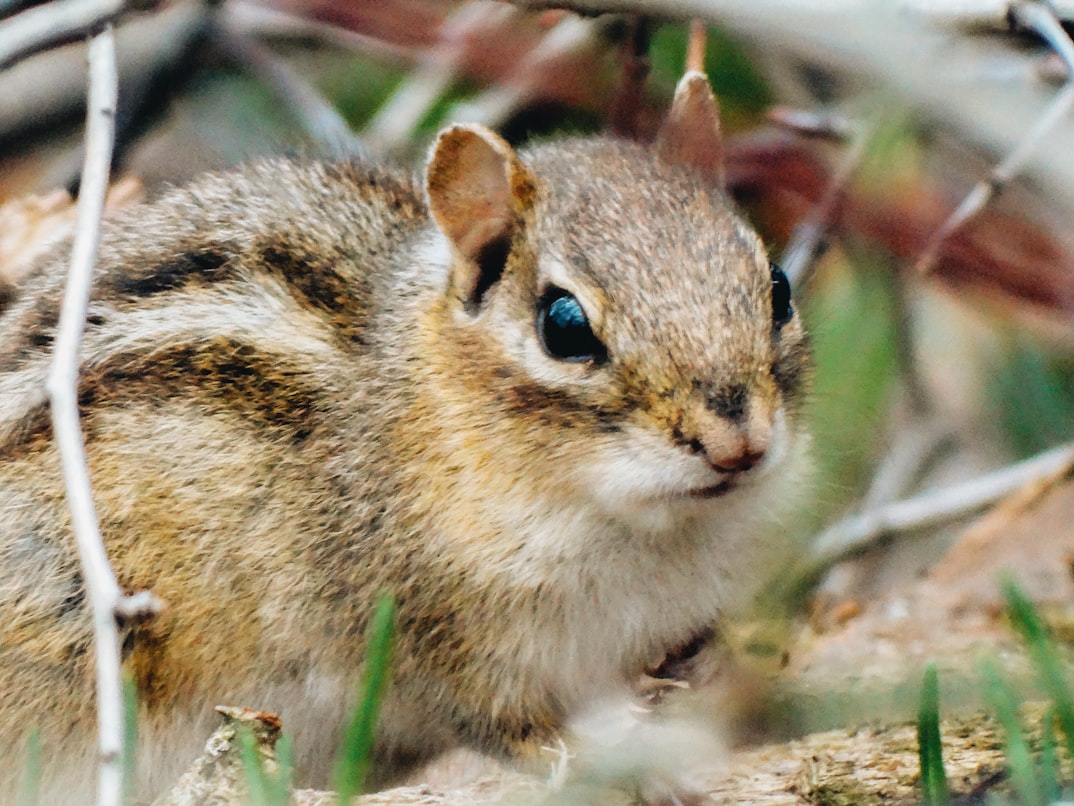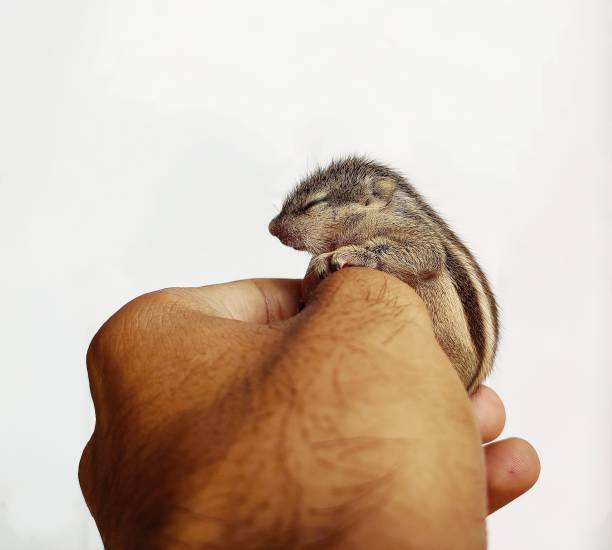As an Amazon Associate I earn from qualifying purchases.
What Do Baby Chipmunks Eat?
In this piece, we look at what chipmunks eat. We’ll talk about their natural diet in the wild and how to feed it to a pet chipmunk. Pet chipmunks may suffer from health issues if they are fed the incorrect food, so we’ll also teach you how to avoid those problems.
Chipmunks are a unique choice of pet for animal lovers who seek something a little more unusual. It’s critical that you feed your chipmunks properly in order to keep them satisfied and healthy. So, to ensure you get it right, we’ve compiled this complete tutorial!
It’s critical to know what chipmunks eat in the wild if you want to pick the right chipmunk food for your pet rodents. So, let’s start by looking at the baby chipmunks’ diet.
What Do Baby Chipmunks Eat?
Chipmunks that have been abandoned or orphaned are most likely to be dehydrated and chilled. Instantly get the chipmunk acclimated. Place him in a warm area with no draught. For extra heat, place the chipmunk beneath a 100-watt bulb.
Select a liquid to assist your chip to rehydrate. Pedialyte for infants is an excellent choice. 1 cc in a syringe should do it. Make sure the environment does not exceed 90 degrees Fahrenheit but can be as low as 75 degrees Fahrenheit.
Provide it to your chipmunk every two hours. Purchase the puppy replacement formula, Esbilac, to feed your chips. Other animal milk replacers and cow milk could cause death.
Feeding an Infant Chipmunk
To take good care of your chipmunk, you must first decipher its age. Chipmunks born after a week will not have any hair on their bodies. Their eyes will also be closed and their size will be 1.5 to 2 inches in length. By the age of 2 weeks old, you will be able to see hair although the eyes will not yet be open.
1 to 2 mL of formula should be given to a newborn chipmunk every 6 hours. Feed between 2 and 3 ml approximately, five times per day by the second week of life. Chips should be kept in a box or basket lined, made out of cardboard, with towels or soft linen. Try not to use newspapers as bedding. This is because the ink is poisonous and can prove to be detrimental for the baby chipmunk. Bed linens should be changed twice on daily basis.
2 Weeks and Above

By four weeks of age, your chipmunk’s eyes and ears will become visible. Three to four ml of formula should be given three times a day at this stage. By five weeks, you can start serving tiny pieces of fruit, such as grapes, apples, and bananas, in addition to the infant formula. As well as feeding it rodent pellets or chow purchased from the pet store.
Your chipmunk will become increasingly energetic at this point. Instead of a cardboard box, house your chip in a plastic pet carrier to limit his chewing abilities. Teethe on twigs for him. By the age of 6 weeks, give him only formula twice a day instead of three times per day as previously advised.
7 Weeks and After
By the time your chipmunk reaches 7 or 8 weeks old, he’ll have a complete, thick coat and will be extremely energetic. Put him in a 2 by 4 by the 4-foot cage. He should be weaned off of formula. Your chipmunk’s diet should include 15% rodent chow, which is split between 50% nuts and 35% fruits. Once your chipmunk is 9 or 10 weeks old, he or she is ready to go in the wild.
How To Feed Pet Baby Chipmunks?

Whether you’re feeding a pet chipmunk or a wild one that comes by frequently in the vicinity of your home, it’s an enjoyable experience. Chipmunks are omnivores like hamsters.
Chipmunks are omnivores that eat a wide range of dry foods, including vegetables and fruits. Chipmunks are hoarders by nature, which is why they keep food in their cheeks during meals, but excessive feeding them may be harmful to their health.
Chipmunks requires the right foods to eat. They love a wide range of foods that include nuts, grains, seeds, vegetables, and fruits. Although chipmunks enjoy peanuts and sunflower seeds, you should restrict their consumption because they are high in calories and the chipmunk could become obese if fed too much.
Grapes, avocado pieces, chopped apples, pine nuts, almonds, walnuts, oats, and dry raisins are all great choices.
If you have a pet chipmunk at home, place pieces of its food in a tiny dish in the cage. When hungry, the chipmunk will eat straight from the dish and possibly store it for later in its cheeks.
Chipmunks like to hide their meals, so place some stuffing in the bottom of the cage for it to bury. To offer variety, alternate between kinds of food such as nuts, fruit, and seeds.
To entice a wild chipmunk to eat from your hands, gradually offer food out and then approach it. If you approach the chipmunk too rapidly, it will flee. Begin by placing a handful of seeds or nuts near where you observe it frequently and walking a distance away until it sees the meal, but close enough for it to see the food.
If the food has been devoured, wait a few hours and repeat the procedure, this time approaching a few feet closer than before. Continue doing so for a few days until you are able to reach out and touch the chipmunk.
Feed dehydrated chipmunk nutrients to keep it hydrated and healthy until it grows large enough to return to the wild or become a family pet. For the first day, give Pedialyte every two hours to hydrate it.
You can offer it Esbilac, a puppy milk replacer, on the second day. By wrapping the chipmunk in a towel and covering its eyes while feeding it with a 1cc oral syringe, you may give both of these nutrients.
How To Feed Wild Baby Chipmunks?
It is not a simple operation to save a wild baby chipmunk. Even if the baby chipmunk will eventually eat, it does not imply that it is completely domesticated. The ASPCA does not support the keeping of wild animals as pets because they are unpredictable and for the animal’s safety. Prior to being given to a wildlife rehabilitation center, getting the chipmunk to eat is a careful operation.
According to the manufacturer’s instructions, combine the puppy formula with water. The baby chipmunk will not take more than a few drops, if any at all, so don’t mix too much at once. Baby chipmunks that have already grown hair and opened their eyes are already weaned. In this situation, the first two phases may be ignored.
After that, hold the medicine dropper over the baby’s snout and gently apply a small drop of the solution. This must be done every two to three hours throughout the day for the first week to two weeks of your baby chipmunk’s life.
Place a bowl of fresh water and birdseed in the cage with the baby chipmunk, but don’t try to make it eat. This might stress the animal out. When feeding time comes, instead of forcing it, nurture the chipmunk’s natural instincts by leaving it alone while eating.
As soon as possible, transport the chipmunk to a wild animal rescue or your local veterinarian. Although puppy formula is an acceptable bandage for acquiring the chipmunk, it doesn’t contain all of the nutrients that a chipmunk needs.
What Are The Natural Predators of Baby Chipmunks?

Chipmunks are delightful little animals, and we can sit and watch them scamper for hours. Of course, humans aren’t the only ones who enjoy seeing chipmunks. Chipmunks are eaten by a variety of animals, both wild and domestic. Chipmunks are considered tasty snacks and excellent meals by a number of species of animals. Chipmunks serve an important function in the ecosystem by acting as a food source for other animals.
Chipmunks are eaten by wolves, foxes, and coyotes in the wild. Baby chipmunks are hunted for a living by aerial predators such as owls and eagles. Chipmunks are also consumed by snakes, which make them an active component of their diet. Let’s take a closer look at these predators in particular.
Mammals
Many animals, such as gerbils and mice, include chipmunks and other rodents in their diets. Weasels, ermines, red foxes, lynxes, coyotes, bobcats, fishers, red squirrels, and raccoons are said to be the biggest predators of chipmunks.
Because different species of chipmunks dwell in various areas throughout the globe, the list of predators varies with geography. When we look at the least chipmunk’s mammal predators, for example, we discover that martens and minks.
A chipmunk may be a simple supper for these hunters at times, but it can also lead to a fruitless chase on other occasions.
Avian Predators
The life of a chipmunk is not an easy one. Not only do they have to worry about foxes on foot pursuing them, but they also must keep their eyes and ears open for birds of prey! Owls and hawks are among the many avian predators that seek out chipmunks.
Snakes
Chipmunks are eaten by snakes of several species. Chipmunk predators include the Black Rat Snake and the Western Diamondback Rattlesnake, which have an insatiable appetite for them.
When compared to the other species on this list, chipmunks and snakes have a more intricate relationship. Chipmunks must rely on speed and agility to escape from species such as people and birds, however, they possess another strategy for dealing with snakes. Chipmunks will frequently battle vicious snakes and even kill them!
How Do Baby Chipmunks Protect Themselves From Predators?
Chipmunks build multichambered underground dwellings, such as the eastern chipmunk. They store their provisions, rear their young, sleep, and spend the winter in their burrows. Chipmunks utilize the safest locations in which they may lay their eggs, such as hollowed-out logs or bushes that offer some protection from potential dangers.
Chipmunks make a sound when danger is nearby so that other chipmunks will be aware of it. When a predator approaches, chipmunks make different noises with their calls and emit a trilling call while being pursued by one. A shrill, repeated chirping indicates impending danger.
The chipmunk’s shrill warning may deter certain predators, such as house cats. When cats lose their element of surprise, they frequently abandon the pursuit, so the chipmunk’s squealing scream serves both as a defense and a signal to others.
Chipmunks may flee danger by retreating to their burrows and remaining hidden where most predators will be unable to find them. Hearing an alert causes a foraging chipmunk to carry less food and take the safest route home possible in order to avoid being harmed.
The Chipmunks pick locations with dense undergrowth, logs, and rock piles in order to hide from predators. He remains vigilant while hunting for food and when he chews, constantly scanning and listening for indications that creatures and birds wish to consume him.
The chipmunk’s greatest safeguard is its speed, especially when alone. It may flee from animals that can’t climb or have poor agility by climbing a tree. It’s out of range of a dog with a single bound.
The tiny rodents will scamper across the ground or along a tree limb to avoid being caught. Its diminutive size allows it to maneuver through thick vegetation and around obstructions to flee from larger animals. A predator may be defeated by vanishing into its burrow or a thicket, providing it with an opportunity to live another day.
Amazon and the Amazon logo are trademarks of Amazon.com, Inc, or its affiliates.

